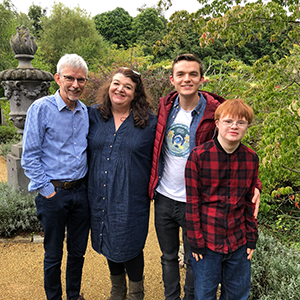About us
 Our family Makaton journey probably first started over 20 years ago when I explored signing for babies after my elder son was born. We then delved further as our younger son William arrived 5 years later. William has Down syndrome, autism plus several medical conditions. He has a hearing loss and has been wearing hearing aids since a baby.
Our family Makaton journey probably first started over 20 years ago when I explored signing for babies after my elder son was born. We then delved further as our younger son William arrived 5 years later. William has Down syndrome, autism plus several medical conditions. He has a hearing loss and has been wearing hearing aids since a baby.
Like many parents we learned Makaton to use at home. I recall we started to sign quite early on with William, then stopped as I couldn’t see William signing back and got quite disheartened. Other kids we knew around his age were picking up signs faster and doing better than him but they did not have his complex health issues going on. We watched Mr Tumble and Singing Hands together then I restarted doing more with him having attended Makaton training and feeling empowered and encouraged by parents of older children who recommended to just keep going. William started to sign, but at a slower pace and in his own way. Makaton and signing remain a big part of his life today as his speech development has been slow. We rely on a mixture of speech, signs and written words. Our use of Makaton has switched focus as he’s grown older to be more age related, be around encouraging communication, choices as well as preparing for adulthood.
My family is the one behind Special iApps C.I.C. specialiapps.org as we’ve been developing educational apps for children with a wide range of special educational needs and disabilities since 2011. During the coronavirus pandemic we started working closely with The Makaton Charity and you can read more about this here Special iApps Collaboration, and also what Sarah and Alfie sarahthemakatontutor.com thought of the The Makaton and Special iApps partnership.
If you’d want to introduce Makaton and are looking for tips, then I’d repeat the advice given to me a long time ago.
- Make it fun, as we all learn more if we enjoy the experience
- Take it easy, introduce one sign at a time that is meaningful to your family then practice and pace yourself
- Use it daily, and incorporate throughout your day weaving signs within your routines
- Keywords, pick out those key words and signs you need for your child you can then build them up to use more together as your child grows and develops
- Repetition, repetition, repetition, practice, practice and practice
- Find a signing buddy, as it’s good to share with someone going through the same thing at the same time and these friendships can last a while, even a lifetime!
One more thing I would add is that your child and your family are unique. Don’t compare. It’s hard not to as we as parents do, but each child is different. You will get a lot of advice from others (both parents and professionals), some of which may just fit into place, others might not. Never be afraid to try, and if you do stop or pause then take a break but do try again. Always give things a second chance and find your own pace that works for your family.
At the very start we learned a handful of signs as and when we needed them and learned more as time went on and William progressed. Over the years I’ve met families whose children signed in their early years and then stopped as they started to talk. For us, with William, it’s been the long haul. Signing is still part of our daily lives seventeen years on as we use it when we need to. Makaton isn’t just for babies but for adults too and covers all aspects of life as children grow into teenagers and then into adulthood. There are some fantastic resources available these days, much more than when we first started our journey. I continue to find new things to do with Makaton and find new resources and realise that there was a lot I didn’t know which I wish I did when he was younger and can also see a lot more that is available and that we can use with him now. Learning is lifelong, so we continue our journey…
Beverley Dean MBE, Founder of Special iApps C.I.C.
specialiapps.org
[email protected]
See also